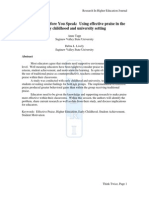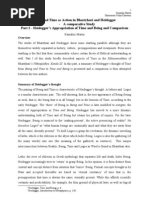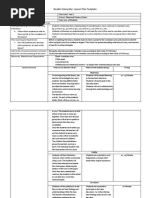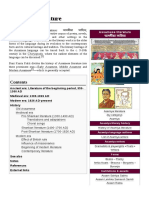Motivating Students: My Students Aren't Motivated - How Can I Help Them?
Motivating Students: My Students Aren't Motivated - How Can I Help Them?
Uploaded by
Sharmistha Talukder KhastagirCopyright:
Available Formats
Motivating Students: My Students Aren't Motivated - How Can I Help Them?
Motivating Students: My Students Aren't Motivated - How Can I Help Them?
Uploaded by
Sharmistha Talukder KhastagirOriginal Description:
Original Title
Copyright
Available Formats
Share this document
Did you find this document useful?
Is this content inappropriate?
Copyright:
Available Formats
Motivating Students: My Students Aren't Motivated - How Can I Help Them?
Motivating Students: My Students Aren't Motivated - How Can I Help Them?
Uploaded by
Sharmistha Talukder KhastagirCopyright:
Available Formats
Motivating Students
This page was written and compiled by Karin Kirk, SERC, and contains a summary of motivation research and pertinent references.
My students aren't motivated - how can I help them?
Teachers have a lot to do with their students' motivational level. A student may arrive in class with a certain degree of motivation. But the teacher's behavior and teaching style, the structure of the course, the nature of the assignments and informal interactions with students all have a large effect on student motivation. We may have heard the utterance, "my students are so unmotivated!" and the good news is that there's a lot that we can do to change that.
Intrinsic and Extrinsic Motivation
Related Links
Engaging students from urban backgrounds
Educational psychology has identified two basic classifications of motivation - intrinsic and extrinsic. Intrinsic motivation arises from a desire to learn a topic due to its inherent interests, for self-fulfillment, enjoyment and to achieve a mastery of the subject. On the other hand, extrinsic motivation is motivation to perform and succeed for the sake of accomplishing a specific result or outcome. Students who are very grade-oriented are
extrinsically motivated, whereas students who seem to truly embrace their work and take a genuine interest in it are intrinsically motivated.
Motivating Students (more info) This chapter from the book Tools for Teaching by Barbara Gross Davis (Jossey-Bass Publishers: San Francisco, 1993) is a great place to start for ideas and tips about increasing student motivation in your classes. The author presents a handy distillation of research on motivation and uses examples and anecdotes that bring this material to life. In addition to general strategies, this chapter addresses successful instructional behaviors, how to structure a course to motivate students, de-emphasizing grades and responding with other types of feedback to students, and tips to encourage students to complete assigned readings. A reference list points the way to more specific information. Excerpts from this chapter: Give frequent, early, positive feedback that supports students' beliefs that they can do well. Ensure opportunities for students' success by assigning tasks that are neither too easy nor too difficult. Help students find personal meaning and value in the material. Create an atmosphere that is open and positive. Help students feel that they are valued members of a learning community.
Motivating Students - from the Vanderbilt Center for Teaching (more info) This website contains a quick and useful primer on many of the important topics in student motivation. Topics include intrinsic and extrinsic motivation, the effect of learning style on motivation and strategies for motivating your students. Here are some recurring themes about student motivation, drawn from the educational literature
Make it real
In order to foster intrinsic motivation, try to create learning activities that are based on topics that are relevant to your students' lives. Strategies include using local examples, teaching with events in the news, using pop culture technology (iPods, cell phones, YouTube videos) to teach, or connecting the subject with your students' culture, outside interests or social lives. ([Brozo, 2005] ; McMahon and Kelly, 1996)
Provide choices
Students can have increased motivation when they feel some sense of autonomy in the learning process, and that motivation declines when students have no voice in the class structure. Giving your students options can be as simple as letting them pick their lab partners or select from alternate assignments, or as complex as "contract teaching" wherein students can determine their own grading scale, due dates and assignments. Kurvink, 1993 Reeve and Hyungshim, 2006 (Perkins 2002, GSA Abstract)
Balance the challenge
Students perform best when the level of difficulty is slightly above their current ability level. If the task is to easy, it promotes boredom and may communicate a message of low expectations or a sense that the teacher believes the student is not capable of better work. A task that is too difficult may be seen as unattainable, may undermine self-efficacy, and may create anxiety. Scaffolding is one instructional technique where the challenge level is gradually raised as students are capable of more complex tasks. (Wang and Han) (more info) , [Margolis and McCabe, 2006] [Adams, 1998]
Seek role models
If students can identify with role models they may be more likely to see the relevance in the subject matter. For example, Weins et al (2003) found that female students were more likely to cite a positive influence with a teacher as a factor for becoming interested in science [Wiens et al, 2003] . In some cases, you can be a role model but it's unlikely that you will connect on that level with everyone in the class due to differences in gender, age and social circles. However there can be many sources of role models, such as invited guest speakers, fellow students or other peers.
Use peer models
Students can learn by watching a peer succeed at a task. In this context, a peer means someone who the student identities with, not necessarily any other student. Peers may be drawn from groups as defined by gender, ethnicity, social circles, interests, achievement level, clothing, or age.[Margolis and McCabe, 2006]
Establish a sense of belonging
People have a fundamental need to feel connected or related to other people. In an academic environment, research shows that students who feel they 'belong' have a higher degree of intrinsic motivation and academic confidence. According to students, their sense of belonging is fostered by an instructor that demonstrates warmth and openness, encourages student participation, is enthusiastic, friendly and helpful, and is organized and prepared for class.[Freeman, Anderman and Jensen, 2007] [Anderman and Leake, 2005]
Adopt a supportive style
A supportive teaching style that allows for student autonomy can foster increased student interest, enjoyment, engagement and performance. Supportive teacher behaviors include listening, giving hints and encouragement, being responsive to student questions and showing empathy for students. Reeve and Hyungshim, 2006 Also see how immediacy in the classroom can be part of a supportive style of teaching. Show me examples of supportive-style teacher behaviors Show me examples of controlling-style teacher behaviors
Strategize with struggling students
When students are struggling with poor academic performance, low self-efficacy or low motivation, one strategy that may help is to teach them how to learn. That is, to
outline specific strategies for completing an assignment, note-taking or reviewing for an exam. [Tuckerman 2003] [Margolis and McCabe, 2006] Example - Strategies for College Success from the Ohio State University. This course teaches learning strategies and motivational skills.
You might also like
- Account Deactivation New Test Case Template Example (2021)Document4 pagesAccount Deactivation New Test Case Template Example (2021)jeffa123No ratings yet
- Motivating StudentsDocument9 pagesMotivating StudentsAgrippa Mungazi100% (1)
- Pedagogies for Student-Centered Learning: Online and On-GoundFrom EverandPedagogies for Student-Centered Learning: Online and On-GoundRating: 3.5 out of 5 stars3.5/5 (3)
- World Famous Tiles Recycled in World Famous VSI - MetsoDocument4 pagesWorld Famous Tiles Recycled in World Famous VSI - MetsoestramilsolutionNo ratings yet
- Motivating StudentsDocument85 pagesMotivating StudentsSurya Ningsih100% (1)
- Group 5 CHAPTER 1 3 REVISEDDocument17 pagesGroup 5 CHAPTER 1 3 REVISEDcristine joy pradoNo ratings yet
- Motivating StudentsDocument11 pagesMotivating StudentsRho Morgan100% (1)
- Dennis Et Al 2007 The Little Engine That Could - How To Start The Motor - Motivating The Online StudentDocument13 pagesDennis Et Al 2007 The Little Engine That Could - How To Start The Motor - Motivating The Online StudenthoorieNo ratings yet
- 5240 Portfolio Activity Unit 8Document9 pages5240 Portfolio Activity Unit 8KUNWAR JEE SINHANo ratings yet
- Five Key Ingredients For Improving Student MotivationDocument23 pagesFive Key Ingredients For Improving Student MotivationPolly Anna100% (1)
- Classroom and Environmental Factors Shaping MotivationDocument31 pagesClassroom and Environmental Factors Shaping MotivationMae SaranteNo ratings yet
- Student Motivation: An Annotated Bibliography by Angela Shaw June, 2014 ED7999 Master's ProjectDocument19 pagesStudent Motivation: An Annotated Bibliography by Angela Shaw June, 2014 ED7999 Master's ProjectSòniaSuñerNo ratings yet
- SELF ASSIGNMENT FIRST - Revised2Document3 pagesSELF ASSIGNMENT FIRST - Revised2Ferriard Lupiya100% (1)
- Advice For Being A TADocument5 pagesAdvice For Being A TARamy M. RadyNo ratings yet
- Era Motivation To Learn 16-12-14Document35 pagesEra Motivation To Learn 16-12-14kumarabhishek910No ratings yet
- GRP 1 Student MotivationDocument22 pagesGRP 1 Student Motivationaris.boostmnlNo ratings yet
- The Role of School and Home in Promoting Student EngagementDocument8 pagesThe Role of School and Home in Promoting Student EngagementMary Ann A. MonaresNo ratings yet
- Session 12 Expectations For Success: Motivation and LearningDocument16 pagesSession 12 Expectations For Success: Motivation and Learningwazim saffieNo ratings yet
- Mirriam Mphepo-Induction AssignmentDocument5 pagesMirriam Mphepo-Induction AssignmentMimikerrisah Mphepo MoyoNo ratings yet
- Students' Lack of Interest, Motivation in Learning, and Classroom Participation: How To Motivate ThemDocument11 pagesStudents' Lack of Interest, Motivation in Learning, and Classroom Participation: How To Motivate ThemPsychology and Education: A Multidisciplinary JournalNo ratings yet
- Childhood Development and MotivationDocument6 pagesChildhood Development and MotivationdeskprecisionNo ratings yet
- Brecke 2007 Cooperative Learning, Responsibility, Ambiguity, Controversy and Support in Motivating StudentsDocument7 pagesBrecke 2007 Cooperative Learning, Responsibility, Ambiguity, Controversy and Support in Motivating StudentshoorieNo ratings yet
- A Road Fullof TDocument28 pagesA Road Fullof Traffy acallarNo ratings yet
- Intrinsic and Extrinsic MotivationDocument2 pagesIntrinsic and Extrinsic Motivationapi-266896222No ratings yet
- Annotated BibliographyDocument3 pagesAnnotated Bibliographyapi-279369297No ratings yet
- Literature Review Domain CDocument5 pagesLiterature Review Domain Capi-323651040No ratings yet
- Untitled Document - EditedDocument9 pagesUntitled Document - Editeddyn keriNo ratings yet
- What Motivation Is and Why It Is Important in Classroom SituationDocument14 pagesWhat Motivation Is and Why It Is Important in Classroom SituationWiljohn de la CruzNo ratings yet
- How To Sustain Students' Motivation in A Learning EnvironmentDocument15 pagesHow To Sustain Students' Motivation in A Learning EnvironmentKha RenNo ratings yet
- ( ) - The Family Environment Is The Sum of Physical and Psychological ConditionsDocument7 pages( ) - The Family Environment Is The Sum of Physical and Psychological ConditionsFatima zahrae KarymNo ratings yet
- Assignment 5Document6 pagesAssignment 5rhina56789No ratings yet
- The Impact of Effective Teacher - Formative Assessement and Positive BehaviorDocument20 pagesThe Impact of Effective Teacher - Formative Assessement and Positive BehaviorProfessora IdealNo ratings yet
- Academic Tenacity: Mindsets and Skills That Promote Long-Term LearningDocument79 pagesAcademic Tenacity: Mindsets and Skills That Promote Long-Term LearningGatesFoundationNo ratings yet
- Motivating Students PresentationDocument26 pagesMotivating Students Presentationapi-717765051No ratings yet
- Research Paper 1Document8 pagesResearch Paper 1api-656454154No ratings yet
- My Teacher Belief SystemDocument4 pagesMy Teacher Belief Systemapi-291289622No ratings yet
- Teacher Motivation DissertationDocument5 pagesTeacher Motivation DissertationCanSomeoneWriteMyPaperForMeMadison100% (1)
- Psychology of LearningDocument4 pagesPsychology of LearningChacheiNo ratings yet
- Team TeachingDocument12 pagesTeam TeachingCarolyn D MayugaNo ratings yet
- The Use of Motivation in Academic ExcellenceDocument23 pagesThe Use of Motivation in Academic ExcellencebenjaminowakaNo ratings yet
- Role of Motivation in Learning Strategy: Oleh: Septika Shania M BR Sinaga 4163131028 Kimia Dik C 2016Document20 pagesRole of Motivation in Learning Strategy: Oleh: Septika Shania M BR Sinaga 4163131028 Kimia Dik C 2016Septika SinagaNo ratings yet
- Didactica Especifica I ResumenDocument38 pagesDidactica Especifica I ResumenAnonymous vWGIbfPNo ratings yet
- Classroom-Ready Resources for Student-Centered Learning: Basic Teaching Strategies for Fostering Student Ownership, Agency, and Engagement in K–6 ClassroomsFrom EverandClassroom-Ready Resources for Student-Centered Learning: Basic Teaching Strategies for Fostering Student Ownership, Agency, and Engagement in K–6 ClassroomsNo ratings yet
- Standard 6Document7 pagesStandard 6api-519224747No ratings yet
- TEFL - Lesson 7.motivationDocument9 pagesTEFL - Lesson 7.motivationHadil BelbagraNo ratings yet
- Topic 10_ Motivation and Learning.Document29 pagesTopic 10_ Motivation and Learning.noreenasyikinNo ratings yet
- Lafrinere Mod I Ra Cor 1-22-2Document7 pagesLafrinere Mod I Ra Cor 1-22-2api-142499642No ratings yet
- Fostering Student Motivation and Engagement MOOCDocument9 pagesFostering Student Motivation and Engagement MOOCEdith Mutindi KavooNo ratings yet
- Example of Intrinsic Motivation StrategiesDocument3 pagesExample of Intrinsic Motivation StrategiesdotdotPindotNo ratings yet
- How Do I Motivate My Students White PaperDocument5 pagesHow Do I Motivate My Students White PapermirfanaminNo ratings yet
- Unit 8 FinalDocument11 pagesUnit 8 Finalapi-310891073No ratings yet
- The Crucial Role of Self-Motivation for Academic SuccessDocument4 pagesThe Crucial Role of Self-Motivation for Academic SuccesssarahlovelykNo ratings yet
- S-Op46Document4 pagesS-Op46susana lourençoNo ratings yet
- Active Learning StrategyDocument16 pagesActive Learning StrategyLiens Li100% (2)
- Seminar 6 The Development of Academic Self-EfficacyDocument27 pagesSeminar 6 The Development of Academic Self-EfficacyAdriana BudaNo ratings yet
- The Goals of Differentiation: Carol Ann TomlinsonDocument6 pagesThe Goals of Differentiation: Carol Ann TomlinsonZhiyong HuangNo ratings yet
- Research Article Summary: Addressing Achievement Gaps With Psychological Interventions by David YeagerDocument4 pagesResearch Article Summary: Addressing Achievement Gaps With Psychological Interventions by David YeagerResearchteam2014No ratings yet
- Intrinsic Motivation in The ClassroomDocument8 pagesIntrinsic Motivation in The ClassroomPrarthana RajkhowaNo ratings yet
- Motivation: Why ISU Values Motivation For LearningDocument2 pagesMotivation: Why ISU Values Motivation For LearningRyan Hopkins-WilcoxNo ratings yet
- G R E S L A: Olden Ules For Ngaging Tudents in Earning CtivitiesDocument3 pagesG R E S L A: Olden Ules For Ngaging Tudents in Earning CtivitiesAdelina SilvaNo ratings yet
- Think Twice Before You Speak: Using Effective Praise in The Early Childhood and University SettingDocument9 pagesThink Twice Before You Speak: Using Effective Praise in The Early Childhood and University SettingPascual Emilio MolinaNo ratings yet
- Project of Element, Need and Nature ofDocument29 pagesProject of Element, Need and Nature ofZain SaeedNo ratings yet
- Cell BroadcastDocument3 pagesCell BroadcastSharmistha Talukder KhastagirNo ratings yet
- LionDocument37 pagesLionSharmistha Talukder KhastagirNo ratings yet
- Fishes of BangladeshDocument8 pagesFishes of BangladeshSharmistha Talukder KhastagirNo ratings yet
- List of Fishes in BangladeshDocument23 pagesList of Fishes in BangladeshSharmistha Talukder Khastagir100% (1)
- Resh Water Fish of BangladeshDocument10 pagesResh Water Fish of BangladeshSharmistha Talukder KhastagirNo ratings yet
- Bangladesh Industrial Finance Company LimitedDocument1 pageBangladesh Industrial Finance Company LimitedSharmistha Talukder KhastagirNo ratings yet
- Dekha Na DekhaDocument66 pagesDekha Na DekhaSharmistha Talukder KhastagirNo ratings yet
- Red Squirrel: For The North American Red Squirrel, See - For The 1993 Spanish Film, SeeDocument13 pagesRed Squirrel: For The North American Red Squirrel, See - For The 1993 Spanish Film, SeeSharmistha Talukder KhastagirNo ratings yet
- ScalyDocument3 pagesScalySharmistha Talukder KhastagirNo ratings yet
- Philippine TarsierDocument14 pagesPhilippine TarsierSharmistha Talukder KhastagirNo ratings yet
- Oar FishDocument5 pagesOar FishSharmistha Talukder KhastagirNo ratings yet
- Nine-Banded ArmadilloDocument10 pagesNine-Banded ArmadilloSharmistha Talukder KhastagirNo ratings yet
- Thermal Conductivity of Insulating MaterialDocument4 pagesThermal Conductivity of Insulating Materialmanojkumar667788990077No ratings yet
- DLP For CO2Document6 pagesDLP For CO2Jessabel AyadNo ratings yet
- Isb Course AssessmentDocument2 pagesIsb Course AssessmentHazieq AushafNo ratings yet
- Arabian-Persian-Literature Group9Document50 pagesArabian-Persian-Literature Group9Jastine Chaed Habagat100% (1)
- Calendar 2015-16Document2 pagesCalendar 2015-16api-268409057No ratings yet
- Animal Science Cheat Sheet: by ViaDocument3 pagesAnimal Science Cheat Sheet: by ViaGlaiza Abad FernandezNo ratings yet
- Hydration of Quaternary Portland Cement Blends Containing Blast-Furnace Slag, Siliceous Fly Ash and Limestone PowderDocument9 pagesHydration of Quaternary Portland Cement Blends Containing Blast-Furnace Slag, Siliceous Fly Ash and Limestone PowderyinglvNo ratings yet
- 25 Words You Didn't Know Were in The DictionaryDocument1 page25 Words You Didn't Know Were in The Dictionary62yykwt4b8No ratings yet
- Bhartrhari HeideggerDocument9 pagesBhartrhari Heideggerkmartin8181No ratings yet
- Money Lesson SequenceDocument10 pagesMoney Lesson Sequenceapi-366373073No ratings yet
- Rathburn Price List May 2024Document5 pagesRathburn Price List May 2024qmuiwthoqdnaldlygjNo ratings yet
- Alumni Management SystemDocument33 pagesAlumni Management SystemE20CA053Santhosh V100% (1)
- Optical LAN Operations Provisioning & MaintenanceDocument2 pagesOptical LAN Operations Provisioning & MaintenanceFilipi TariganNo ratings yet
- PATHFIT 3 Module 6 Fundametal Dance Postions and StepsDocument35 pagesPATHFIT 3 Module 6 Fundametal Dance Postions and Stepsburgosjeiar19No ratings yet
- BiologyDocument984 pagesBiologyGary Fearless Edwards88% (8)
- Lesson Plan:: Teacher Name: Grade: SubjectDocument2 pagesLesson Plan:: Teacher Name: Grade: SubjectViennaDumaganNo ratings yet
- Uworld NotesDocument7 pagesUworld NotesJorge L CastelarNo ratings yet
- Bottle Blowing & FillingDocument14 pagesBottle Blowing & Fillingmichael odiemboNo ratings yet
- The Use of Bubble CPAP in Premature InfantsDocument7 pagesThe Use of Bubble CPAP in Premature InfantsRyan Rahman OesmanNo ratings yet
- MATLAB Quick GuideDocument126 pagesMATLAB Quick GuideAmit KumarNo ratings yet
- Computer ArchitecturDocument6 pagesComputer ArchitecturechandanaNo ratings yet
- MAXON CINEMA 4D R18 Studio A Tutorial Approach 5th Edition Sham Tickoo All Chapters Instant DownloadDocument65 pagesMAXON CINEMA 4D R18 Studio A Tutorial Approach 5th Edition Sham Tickoo All Chapters Instant Downloaddeylestomagp100% (1)
- (ALPHA) Board Exam Checklist & Retrospective Revision Timetable 2024-25Document22 pages(ALPHA) Board Exam Checklist & Retrospective Revision Timetable 2024-25nchaitanyakatkamNo ratings yet
- Inflation & UnemploymentDocument13 pagesInflation & UnemploymentNathaniel MadugaNo ratings yet
- Input Output Devices AssignmentDocument6 pagesInput Output Devices Assignmentpubg broNo ratings yet
- CCS 3105-Systems Programming - 1Document40 pagesCCS 3105-Systems Programming - 1ben munjaruNo ratings yet
- November 29, 2020 (1st Sunday Advent) PDFDocument3 pagesNovember 29, 2020 (1st Sunday Advent) PDFKaty PutnamNo ratings yet
- Assamese LiteratureDocument10 pagesAssamese Literaturetiyasee25No ratings yet





































































































